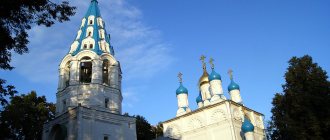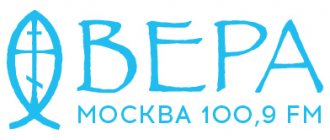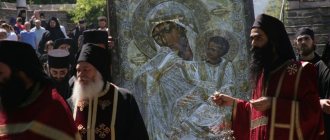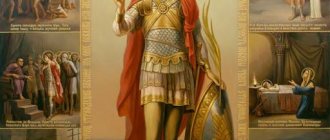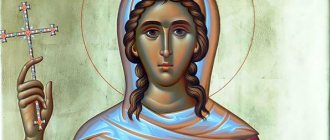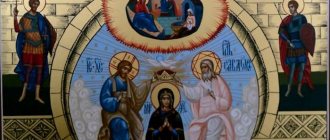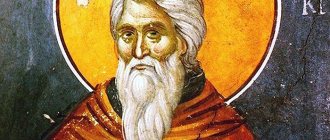History of the icon
Andrei Bogolyubsky, trying to strengthen his influence and seize power, gathered appanage princes and began to besiege Russian cities. In 1170 he stood under the walls of Novgorod. Local residents and soldiers defended themselves desperately. On the third day they gathered and began to pray to God. During this ritual, Archbishop John of Novgorod heard a voice from heaven. He ordered him to bring to the city walls the icon of the Mother of God, located in the Church of the Transfiguration.
When the icon was placed on the wall, the Suzdal residents fired a cloud of arrows in its direction. One fell into the holy image. The Mother of God began to tear up - she cried, and turned her face towards the city. Seeing such a miracle, the enemy panicked. The warriors began to fight each other.
Inspired Novgorodians rushed into battle with renewed vigor and defeated the enemy and did not allow them into their city. Archbishop John established the feast of the image of the Mother of God on December 10 in honor of the event. So the great Novgorod became the owner of the shrine - they had the first icon of the Mother of God called the Sign.
During its existence, the icon of the Sign of the Most Holy Theotokos changed its location several times. In 1354, it was solemnly transferred to the Church of the Sign of the Virgin Mary. Two centuries later, in 1560, it was returned to the Transfiguration Church and soon moved to the nearby Znamensky Cathedral. During the period of fighting against God, the icon of the Most Holy Theotokos of the Sign was removed for display in the museum. And only in 1991 the image of the Mother of God returned to its rightful place, in Novgorod, in the Cathedral of the Sign.
Currently, there are several icons of Our Lady of the Sign throughout the country. They are distinguished by location: Verkhnetagilskaya, Kursko-Korennaya, Solovetskaya, Tsarskoye Selo, Vologda.
Icon of the Mother of God “The Sign”
In Russia, believers have always treated the Mother of God with special reverence and love. Her images, including the icon of the Mother of God “The Sign,” are especially revered. There are numerous examples of the miraculous intercession of the Mother of God for the people who pray to Her for help. The Virgin Mary is the only person in the world into whom God Himself entered. The Immaculate Virgin gave birth to the world of the God-man Jesus Christ.
Icon of the Mother of God “The Sign”
“The personal merit of the Blessed Virgin is that she prepared herself to receive the Savior. This was her personal, freely accepted feat. The purity of her life, the deepest love, complete self-denial and absolute loyalty to God - all this was not found in any of the righteous people of Old Testament antiquity to such a degree” (St. Ignatius Brianchaninov).
Therefore, widespread veneration of the Queen of Heaven through her holy images is natural. After all, icons are often the visible evidence of the miracles of the Mother of God.
The icon is called the “picturesque Gospel”, “wordless sermon”, “window into the invisible world”. The Orthodox worship the Mother of God herself, depicted on the icon, and not boards and paints, as iconoclasts believe.
“When you see the icon of the Most Holy Theotokos, turn your heart to Her, the Queen of Heaven, and thank Her for the fact that She appeared so ready to submit to the will of God, that she gave birth, nurtured and raised the Savior of the world, and that in our invisible battle she never fails Her intercession helps us” (Reverend Nicodemus the Holy Mountain).
One of these miraculous images is the Icon of the Mother of God “The Sign”.
On the icon “The Sign” the Mother of God is depicted with her arms raised and outstretched to the sides. This is evidence of Her intercessory prayer. On the chest of the Mother of God in a medallion (or in a sphere) sits the Divine Infant. This is one of the first iconographic images of the Virgin Mary, dating back to the 4th century. In Rus', an icon of this type of icon painting became widespread in the 11th-12th centuries. It began to be called “The Sign” after a miraculous event that occurred in Novgorod.
The meaning of the icon of the Mother of God “The Sign”
The word “sign” has several meanings, which are used in different languages at one time or another in history. All of them are to a certain extent connected with the image of the Virgin Mary.
The first meaning is a sign of the Virgin Mary herself, in the sense of the word “knowledge”. After all, only she knew about the imminent birth of Christ, the son of God.
Dahl's dictionary lists several meanings of the word “sign”: sign, omen, birth, sign, natural phenomenon, miracle, foreshadowing.
The sign of the icon of the Mother of God lies in its prediction of the coming of the Savior to the world. In this case, the Virgin Mary herself is the herald of the birth of the future Messiah.
At the same time, the Holy Virgin is a sign in the sense of the banner of the victors in a righteous struggle during internecine wars.
When the image of the Mother of God was hit by an arrow, she did not cry because of the pain caused to her, she shed tears for the fate of Rus', mired in the sin of fratricidal wars that tortured the people and entailed death and suffering.
The tears of the Virgin Mary were a prediction of the difficult fate of the state. Weakened by internecine disputes and strife, it became easy prey for the Mongol conquerors.
Temples in honor of the Sign of the Blessed Virgin Mary in Rus'
In the village of Grushevka, Sudak region (Crimean Peninsula), between 1361 and 1381 a church was built in honor of the Sign of the Blessed Virgin Mary. The church has an unusual appearance: a large rectangular building made of rubble stone, decorated with modest pediments, was rebuilt many times, but has preserved almost all the evidence of its centuries-old history.
Temple in honor of the Sign of the Blessed Virgin Mary in the village. Grushevka (Crimea)
In 1625, the Church of the Archangel Michael Monastery in Yuryev-Polsky . The temple occupies the southern side of the monastery courtyard and has the usual layout and design for 17th-century buildings of this type. This is a simple low temple with a spacious refectory.
Znamenskaya Church of the Archangel Michael Monastery in Yuryev-Polsky
In honor of the Sign of the Most Holy Theotokos, a temple was consecrated in Moscow, in Medvedkovo . In the fall of 1612, in the village of Medvedkovo, devastated during the Time of Troubles, a military prayer service was held before the decisive battle with the Poles for Moscow under the leadership of Dimitri Mikhailovich Pozharsky and Kuzma Minin. In memory of this event, in 1620, at the expense of Pozharsky, the first wooden tent church was erected and a memorial bell was cast for it in honor of the liberation of Moscow. In 1634-1635 In memory of his untimely deceased beloved son Fyodor, Pozharsky ordered the replacement of the wooden church with the existing stone tented church, one of the last examples of this style, since soon Nikon’s church reform banned this type of religious buildings as “not corresponding to the rank.”
Church of the Sign in Moscow, in Medvedkovo
In Moscow on Znamenka there was a temple in the name of the Sign of the Blessed Virgin Mary. The first mention of the temple dates back to the beginning of the 17th century, during the interrogation of followers of False Dmitry. It is also known that one of the church bells had the inscription “alms from the parish people”, which appeared in 1600. The Znamenskaya Church was located on the corner of Znamenka Street and Bolshoy Znamensky Lane (Znamenka, vl. 17), which were named after this church. The temple became stone in 1646, later rebuilt in 1657, and the bell tower itself was erected ten years later. In 1929, the church was closed, and two years later it was completely destroyed.
Znamensky Church in Moscow
In honor of the Sign of the Most Holy Theotokos, the altar of the Church of the Nativity of the Virgin Mary in Volokolamsk (1535), the Church of St. Nicholas in Kolomna (circa 1530), the Church of St. Nicholas in Pskov (1500) and the St. Nicholas Church in the village were consecrated. Upper Bridge of the Pskov region (1450).
Description and photo of the icon
Images of the Mother of God on the paintings “The Sign” are found half-length and full-length. The icon is made in the ancient style of “oranta”, which means “praying”. The photo shows that the Virgin Mary’s arms are raised up, her palms at shoulder level are open and turned forward. For a long time, after the Nativity of Christ, it was in this position that Christians prayed, opening their hands to receive divine energy.
At the level of her chest, in the area of the heart, in the sphere there is an image of the Savior-Emmanuel, a symbol of Christ at the age of a youth. Jesus holds the Holy Scripture - a scroll in his left hand. With his right hand, with folded fingers, he blesses the laity.
Prayer before the icon
Troparion to the Most Holy Theotokos, tone 4
Kontakion to the Most Holy Theotokos, tone 4
Glorification of the Most Holy Theotokos before the Icon of the Sign
When reading the text in front of the holy image, it is important for those praying to remember that they are not addressing the icon itself - the board with the image, but the Mother of God herself. Only in this case will prayer help. People turn to Our Lady asking for help in all difficult life situations, grief and illness. When thinking about how the “Sign” icon helps, you should pay attention to its history; it is an intercessor and protector of peace and tranquility.
They pray before the image of Our Lady of the Sign if there is discord in the family, there is no peace and understanding. People with blindness and those suffering from eye disease turn to the images. Their relatives and even friends can also ask for them, so that close people can see the light and be able to see the world.
The Icon of the Sign, better than other images of the Mother of God, helps to reconcile warring parties and get rid of strife, especially internecine ones. The icon of the Sign is powerful in protecting against the spread of epidemics. They are protected by it when there is a threat of fire.
The conversation with the Mother of God should take place in a calm atmosphere. Words of petition come from the soul and suffering heart. You should put the “Sign” icon of the Mother of God. The size of the image does not matter, it simply helps to focus on the image, serves to understand the dialogue with the saint, and not just pronounce the memorized texts.
You should calm down, concentrate, and put aside daily worries and troubles for a while. A lamp lit with incense will help with this. To set the mood for a conversation with the Most Holy One, it is advisable to read “Our Father” and “Virgin Mother of God, Rejoice” three times. After this, begin prayer in front of the icon of the Sign. For this case, the priests recommend the Troparion to the Most Holy Theotokos, tone 4 and kontakion, tone 4. After this, the believer can present the problem in his own words.
When celebrating the day of the icon on December 10, in the church in front of the image of the Mother of God the Sign is read, as well as the canons, Song 1 and Song 3, Sedalen, tone 8, songs 4-6 and Kontakion, tone 4 and other troparia and akathists.
RECOMMENDED: Preparation for communion and confession for beginners.
Texts of prayers to the Mother of God in front of the icon “The Sign” in Russian
The troparion and kontakion are read the same way for the Novgorod and Tsarskoye Selo faces of the Mother of God.
Troparion
Like an insurmountable wall and a source of miracles, / having acquired Thee, Thy servants, Most Pure Mother of God, / we overthrow the resistant militias. / We also pray to Thee, / grant peace to our fatherland // and great mercy to our souls.
Kontakion
Come, faithful ones, let us brightly celebrate / the miraculous appearance of the all-honorable image of the Mother of God / and from this we draw grace, / let us most tenderly cry out: // Rejoice, Mary Theotokos, Blessed Mother of God.
Prayer
O Most Holy Virgin, Mother of the Lord of the Highest Powers, Queen of heaven and earth, Almighty Intercessor of our city and country! Receive thanksgiving and glory from us, unworthy Thy servants, and lift up our prayers to the Throne of God Thy Son, that He may show us a sign of His mercy and add His grace to those who honor Thy All-Honorable Name and worship Thy miraculous image with faith and love. For we are not worthy of being shown mercy by Him, unless You propitiate Him for us, O Lady: all that is possible for You from Him is possible. For this reason, we resort to You, as to our undoubted and immediate Intercessor. Hear us praying to You, cover us with Your Almighty Protection, and ask from the Lord Almighty for the Russian Orthodox Power peace, health, salvation and good haste in everything: our shepherd is zeal and vigil for souls, the city ruler is wisdom and strength, the judges are truthful and impartial, a mentor reason and humility, love and harmony for a spouse, obedience for children, patience for those who are offended, fear of God for those who are offended, complacency for those who grieve, blessing for those who rejoice, health for those in pain, intercession for those who are admonished, but we all have the spirit of faith and piety, the spirit of mercy and meekness, the spirit of purity and truth. to her, the Queen Offering! Have mercy on Thy weak people: gather those who are scattered along the paths of the world, guide those who have gone astray to the right path, strengthen old age, educate youth with chastity, raise infants, and look upon us all with the care of Thy Motherly mercy: raise us up from the depths of sin and enlighten the eyes of our hearts to the vision of salvation. Be merciful to us here and there, in the land of earthly arrival and at the Last Judgment of Your Son: those who died in faith and repentance from this life, our fathers and brethren, may live with the angels in eternal life and with all the saints. You are ecu, Lady, the Glory of the heavenly and the Hope of the earthly, You, according to God, are our Hope and Intercessor of all those who flow to You with faith. We therefore pray to You, and to You, as the Almighty Helper, we commit ourselves and each other, and our whole life according to Christ God, now and ever and unto ages of ages. Amen.
Questions for the priest
Christians venerate the Mother of God and are interested in which icons in the Oranta style are older than the Novgorod “Sign”.
While dismantling the catacombs of Callistus in Rome, a fragment of a painting with the Virgin Mary was found on the vault. She is depicted praying, with outstretched arms, but without the baby. The image dates back to the second half of the 3rd century.
In Palestine in the 6th and 7th centuries, the praying Mother of God was depicted on the ampoule of Monza. The surface of the vessel was covered with several drawings, limited to circles.
In Serbia, a fresco painted in the 14th century has survived to this day. On it, the Mother of God in a tunic is drawn in full growth. On her chest is Emmanuel in a circle.
Old Believer churches in honor of the Sign of the Blessed Virgin Mary
Having been initially locally revered, the Novgorod holiday of the Sign of the Blessed Virgin Mary became all-Russian by the 16th century. He is also highly revered by Old Believers.
In 1720, the Church of the Russian Orthodox Church in Kaluga was consecrated in honor of the Sign of the Most Holy Theotokos. The church operated until 1937, and in December 1941 it found itself at the center of the battles for the liberation of Kaluga from occupation, but, thank God, it survived. During Soviet times, the temple was used as a warehouse for textile products. In March 1989, the Kaluga Regional Executive Committee granted the persistent requests of the Old Believer community to provide it with a more spacious prayer building. On March 2, 1995, the church was consecrated by His Eminence Alimpiy, Metropolitan of Moscow and All Rus'. It was decided to leave the main church in Znamensky, in honor of the Sign from the icon of the Blessed Virgin Mary in Veliky Novgorod. The chapel was consecrated in the name of St. Nicholas.
Church of the Russian Orthodox Church in the name of the Sign of the Blessed Virgin Mary in Kaluga
In the village Bobrovka, Republic of Kazakhstan, in the name of the Sign of the Most Holy Theotokos, the Church of the Russian Orthodox Church was consecrated.
Church of the Sign of the Blessed Virgin Mary. Bobrovka (RPsC)
In Orenburg there is the Znamensky Church of the Russian Orthodox Church. The brick Old Believer prayer house was transferred to the Old Believers community in 1892, after 1905 it was rebuilt. It was closed in 1931. In 1993 it was returned to the Russian Orthodox Church and repaired.
Church of the Sign of the Blessed Virgin Mary. Orenburg
In the village In Churovichi, Bryansk region, there is the Znamensky Church of the Russian Orthodox Church, built in 1870. The Russian-style temple, characteristic of this time, is an emphatically massive domed building with a cross-shaped volumetric composition and a tiered bell tower. The church building has a pentagonal apse and a cylindrical light drum with a large onion-shaped dome. A high three-tier bell tower adjoins the rectangular refectory from the west; above the center of its wide lower tier rise the quadrangle and octagon of the bell.
Church of the Sign of the Blessed Virgin Mary. Churovichi (RDC)
In honor of the Sign of the Most Holy Theotokos, the Church of the DOC in St. Petersburg, in Rybatskoe, was consecrated. The wooden church was founded on May 9, 1882 and consecrated in the name of the Kazan Icon of the Mother of God on November 1, 1883. In 1887–1889, a spacious stone vestibule with a bell tower was added to the church. At the end of the 1920s, the temple was closed, the wooden part of the temple was dismantled. Until 1961, the church building housed the warehouse of the Neva Artel. In the same year, services began. The building in 1961 was transferred to the Orthodox Old Believer community of the Bespopovtsy Pomeranian Consent. The surviving buildings were repaired and the destroyed church was partially restored, reconsecrated by the community as Znamenskaya. Since 1961, services have resumed in the church.
Church of the Sign of the Blessed Virgin Mary. St. Petersburg (DPC)
Another church of the DOC in St. Petersburg was consecrated in honor of the Sign of the Most Holy Theotokos. The church was built in 1906–1907. Old Believer community of the Pomeranian consent.
Church of the Sign of the Blessed Virgin Mary in St. Petersburg (DOC)

